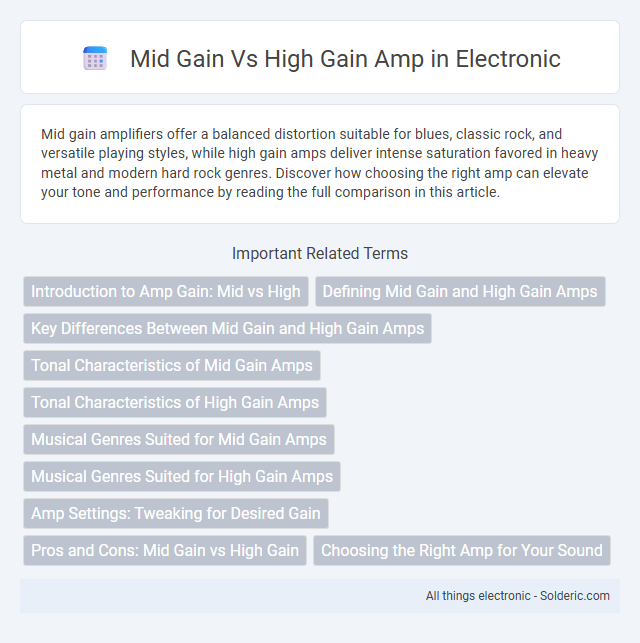Mid gain amplifiers offer a balanced distortion suitable for blues, classic rock, and versatile playing styles, while high gain amps deliver intense saturation favored in heavy metal and modern hard rock genres. Discover how choosing the right amp can elevate your tone and performance by reading the full comparison in this article.
Comparison Table
| Feature | Mid Gain Amp | High Gain Amp |
|---|---|---|
| Gain Level | Moderate distortion, balanced tone | High distortion, aggressive tone |
| Ideal Genre | Blues, Classic Rock, Indie | Metal, Hard Rock, Modern Heavy |
| Sound Clarity | Clearer, more dynamic response | Heavily saturated, compressed sound |
| Use Cases | Lead solos, rhythm with moderate overdrive | Heavy riffs, drop tunings, aggressive playing |
| Common Controls | Gain, EQ, Presence | Gain, EQ, Noise Gate |
| Noise Level | Lower noise floor | Higher noise, often requires noise suppression |
| Examples | Fender Hot Rod Deluxe, Vox AC30 | Peavey 6505, Mesa Boogie Dual Rectifier |
Introduction to Amp Gain: Mid vs High
Amp gain determines the level of signal amplification, affecting tonal character and distortion. Mid gain amps provide moderate distortion suitable for blues and classic rock, delivering warmth and dynamic responsiveness. High gain amps produce intensive distortion favored in metal and hard rock, offering aggressive tones and sustain for your heavier playing styles.
Defining Mid Gain and High Gain Amps
Mid gain amps deliver moderate distortion levels, ideal for blues and classic rock tones with clarity and touch sensitivity. High gain amps produce intense distortion and sustain, favored in metal and hard rock for aggressive, saturated sounds. Your choice between mid gain and high gain depends on the genre and the level of distortion you want to achieve.
Key Differences Between Mid Gain and High Gain Amps
Mid gain amps deliver moderate distortion levels ideal for classic rock and blues, offering clarity and warmth without excessive compression. High gain amps produce intense distortion suited for metal and hard rock, featuring tight low-end response and aggressive sustain. Your choice depends on the tonal clarity you need and the music genre you play, with mid gain amps balancing articulation and crunch while high gain amps emphasize saturation and heaviness.
Tonal Characteristics of Mid Gain Amps
Mid gain amps deliver a balanced tonal spectrum that emphasizes clarity and warmth, making them ideal for achieving classic rock and blues sounds with moderate distortion. These amps provide enough overdrive to enhance dynamic playing while preserving note definition and articulation, ensuring each note remains distinguishable. Your tone benefits from smooth mids and controlled bass, offering versatility without overwhelming saturation.
Tonal Characteristics of High Gain Amps
High gain amps deliver intense distortion characterized by tight, saturated tones and pronounced harmonic complexity, ideal for heavy metal and hard rock genres. These amps emphasize sustain and aggressive midrange frequencies, producing a thick, powerful sound with substantial compression. Their tonal profile often includes scooped mids and boosted bass and treble, providing clarity and definition in high-gain settings.
Musical Genres Suited for Mid Gain Amps
Mid gain amps excel in genres like blues, classic rock, and jazz where warm, gritty tones enhance expressive playing without overpowering nuances. They deliver smooth overdrive and dynamic response, allowing your guitar to sing with subtle harmonic richness. This balance makes mid gain amps ideal for versatile musicians seeking clear articulation and organic breakup in their sound.
Musical Genres Suited for High Gain Amps
High gain amps are ideal for musical genres like metal, hard rock, and punk where aggressive distortion and sustained overdrive are essential for the signature tone. These amps emphasize tight, saturated distortion that enhances heavy riffs and complex palm-muted techniques. Your choice of amp gain directly influences your ability to achieve the raw power and clarity required for these intense styles.
Amp Settings: Tweaking for Desired Gain
Adjusting your amp settings to achieve the desired gain involves balancing the mid gain and high gain controls to shape the distortion and tonal clarity. Mid gain amps provide a smoother, more controlled overdrive suitable for blues and classic rock, while high gain amps deliver aggressive saturation ideal for metal and heavier genres. Fine-tuning the gain, EQ, and presence knobs empowers you to dial in the perfect response for your playing style and musical context.
Pros and Cons: Mid Gain vs High Gain
Mid gain amps offer a balanced tonal range that preserves clarity and articulation, making them ideal for genres requiring both clean and distorted sounds, but they might lack the intense saturation high gain amps provide. High gain amps excel in delivering aggressive distortion and sustain, perfect for heavy metal and hard rock, though they can sometimes cause tonal muddiness and reduced note definition. Your choice depends on whether you prioritize versatile dynamics and clarity (mid gain) or powerful, saturated distortion with less emphasis on precision (high gain).
Choosing the Right Amp for Your Sound
Mid gain amps deliver a balanced tone with moderate distortion, ideal for classic rock and blues, while high gain amps provide intense saturation suited for metal and heavy rock genres. Your choice depends on the desired level of distortion and clarity, as mid gain offers cleaner dynamics and high gain emphasizes aggressive, saturated sounds. Focus on the specific tonal characteristics and genre compatibility to select the amp that best matches your playing style and sound preferences.
mid gain vs high gain amp Infographic

 solderic.com
solderic.com